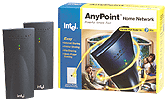At first glance it looks like Intel really has a winner with it’s new AnyPoint home
networking product. But if you take a second look you will see that it has some major
stumbling blocks. First off let me tell you what it is. AnyPoint is a combination of
hardware and software.
At first glance it looks like Intel really has a winner with it’s new AnyPoint home networking product. But if you take a second look you will see that it has some major stumbling blocks.
The basic kit includes
2 parallel port network adapters (that use your home phone lines to communicate)
the cables to go from the PC to the AnyPoint adapter
the cables to go from the AnyPoint adapter to the phone jack on your wall
the power supplies for the adapters
the software to automatically configure the whole shebang
90 day worth of 800 number free support.

The hardware was really thought through nicely. They give you not only a pass though
for the printer port but even one for the phone line so you don’t have to run out and buy
a line splitter. The software only asks you 2 questions during the whole install. What do
you want to name your computer and which computer has the modem. So in about 20 minutes
you can have your home network up and running with 2 computers. You can buy add-on packs
for each additional computer you want to hook up to the network. The kit lists for $189.00
the add-on pack for $99.00 and you can also get a PCI model for $79.00 (if you want to
open the box and install it). This technology is based on the Home Phoneline Networking
Alliance and is not proprietary, so you can add products from other vendors to your
system. The system run a 1 Mbps which is slow compared to office standards but probably
adequate for the home user. This is the HomePNA 1.0 spec. They are now working on a
upgraded spec to deliver 10 Mbps, but this is up to the Alliance I am sure Intel will be
ready when the new spec is solidified. So far so good right?
Now for the draw backs. A lot of the multiple computer households are 1 desktop machine
and a road warriors notebook. Well if the road warrior logs into a domain at work they
will not be able to install the AnyPoint software on their notebook. It looks for a
configured logon client like NT or Novel and if it finds one the Software install aborts.
If the road warrior only log onto a peer to peer network at work the software will load.
Which brings us to the second problem. When the install asks them to name their machine,
there is no warning not to change the name of the computer, if they use another network.
So when they change the name of the computer to the room it is located in, which is the
recommended naming convention; they are actually changing the net bios name of the
computer potentially breaking any drive or folder mapping at work, not to mention any UNC
paths. And you know who is going to get the grief when these things happen, you and me the
lowly admin. Why did you sabotage my computer so it will not work on my home network? How
come my secretary can’t see my excel expense report anymore, ect?
There is another more subtle issue also. There are only 2 places you can buy AnyPoint
other than in a system from GateWay or IBM. You can buy it from CompUSA or directly from
Intel’s web site (www.intel.com/anypoint).
What happened to the channel. I have a feeling this is going to come back to haunt Intel.
When the Fry’s and the MicroCenter’s ect try to buy this product and find out
Intel won’t sell it to them, whose CPU’s and Nic’s do you think are going
to get the good floor space? I’m guessing this is going to really help AMD’s and
3com’s sales figures.
So in closing let me say, this is a really great product if you want a network in your
home and you don’t want to connect it to your laptop. If you just have 2 or 3 or more
computers in your house this is the least expensive no hassle way to get a real network up
and running. But if you run a network for a company you may want to think about putting
out a warning to your road warriors to not try to install the AnyPoint system in their
notebooks.
Trademarks, CopyRights and Brand Names are property of their respective owners
Author and/or Publisher assumes no responsibility, use these suggestions and guidelines at
your own risk

